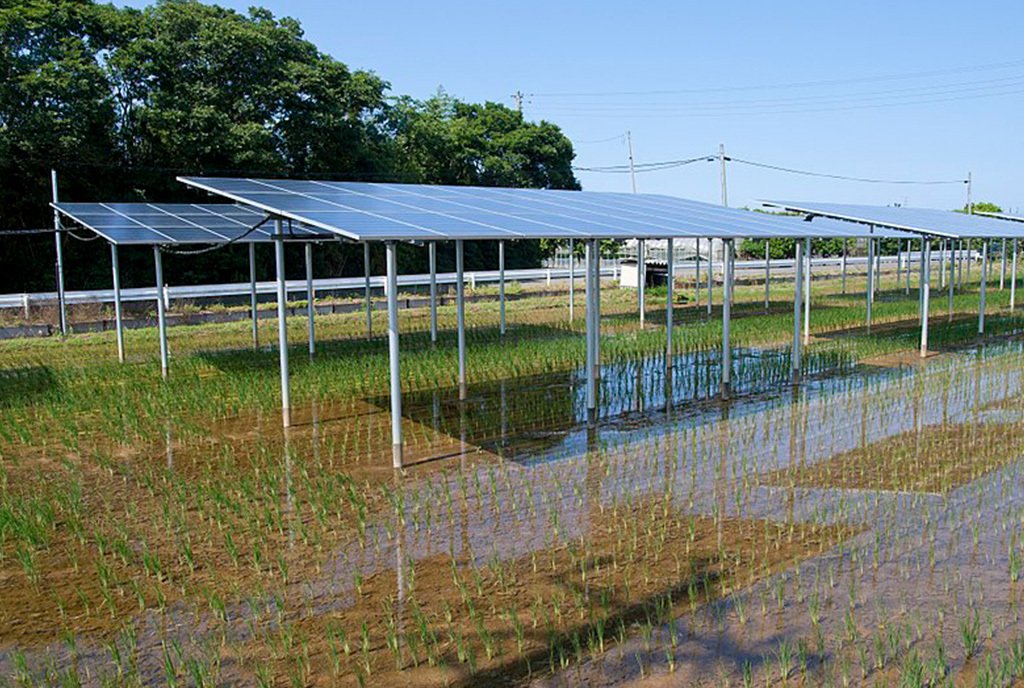
With the effects of climate change intensifying, the American West faces an array of challenges. Hotter and drier conditions have led to early snow melting, reduced water availability, and diminished crop yields. And there’s also the issue of power shortages. Amidst this adversity, however, the pioneering solution of agrivoltaics offers hope for farmers and the environment.
How Agrivoltaics Helps the Climate Crisis
Agrivoltaics, also known as agrovoltaics or dual-use solar farming, is a sustainable agricultural practice that combines crop cultivation with solar panels on the same piece of land. This approach maximizes land use efficiency and resource utilization.
Solar panels are mounted at an elevated height to create shaded areas where crops can grow underneath. The shade provided to the crops reduces water evaporation and temperature stress, leading to increased crop yields and better water management. At the same time, the crops help cool the surrounding area and improve the efficiency of the solar panels by making them less prone to overheating. And there are several other ways that agrivoltaics can be used to mitigate the effects of climate change:
- Renewable Energy
By generating solar power, agrivoltaics reduces reliance on fossil fuels and decreases greenhouse gas emissions.
- Land Efficiency
Agrivoltaics prevents the need for additional land conversion for solar farms, which can lead to deforestation and habitat destruction.
- Carbon Sequestration
Growing crops alongside solar panels can enhance carbon sequestration in soils, aiding in carbon dioxide removal from the atmosphere.
- Biodiversity Preservation
Agrivoltaics maintains habitat for wildlife, promoting biodiversity and supporting ecosystems.
- Local Food Production
Combining solar energy with agriculture allows local food production, reducing transportation emissions from importing produce.
- Resilience
Diversifying land use makes farms more resilient to extreme weather events and economic uncertainties.
Currently, 22 locations across the United States are experimenting with the use of agrivoltaics, including Jack’s Solar Garden in Longmont, CO.
Case Study: Jack’s Solar Garden
A 24-acre family farm purchased by Jack Stingerie in 1972 that grew hay and wheat and hosted cattle, Jack’s Solar Garden has now evolved into a model for how to produce energy and food in tandem.
Father and son Kurt and Byron Kominek—along with researchers from the US Department of Energy, the National Renewable Energy Laboratory (NREL), Colorado State University, and University of Arizona—have converted the farm to an agrivoltaic endeavor, utilizing solar energy to cultivate crops and plants.
Audubon Rockies, a regional branch of the National Audubon Society, created their most extensive Habitat Hero pollinator area in Colorado surrounding the solar array of the farm. Concurrently, a local nonprofit farming group called Sprout City Farms educates young farmers in cultivating crops beneath Jack’s solar panels. As of early September 2021, Sprout City Farms had provided over 1,500 pounds of produce to the local nonprofit OUR Center in Longmont.
“Jack’s Solar Garden was named after my grandfather, as we wanted this project to do more for our family as well as the community Jack moved us into,” said Byron Kominek, Jack’s Solar Garden owner and manager. “We couldn’t have built this agrivoltaics system without the support of our community, from the Boulder County government that enabled us to build the solar array with a forward-looking land-use code and clean-energy-centric regulations to the companies and residents who purchase power from us.”
The location produces sufficient electricity for over 300 households through its 1.2-megawatt capacity and 3,200 solar panels.
Through the establishment of the Colorado Agrivoltaic Learning Center, Jack’s Solar Garden has also successfully introduced communities to the future of agrivoltaics, inviting local schools and community groups to tour the farm. In 2021, Jack’s Solar Garden welcomed over 500 guests on-site and reached an additional 600 through off-site presentations. These tours and presentations serve as a source of inspiration and education, highlighting the potential of clean energy, local food production, and responsible land management.
“Jack’s Solar Garden provides us the most comprehensive and largest agrivoltaics research site in the nation while also providing other food access and educational benefits to the surrounding community,” said Jordan Macknick, principal investigator for InSPIRE, (Innovative Solar Practices Integrated with Rural Economies and Ecosystems). “It serves as a model that can be replicated for greater energy security and food security in Colorado and the nation.”
Ongoing Research
Nationwide, researchers are meticulously studying the intricate relationship between solar panels, crops, and water conservation, striving to optimize crop productivity, resource utilization, and environmental sustainability. Along with the research site of Jack’s Solar Garden, other examples include the University of Arizona’s Biosphere 2 in Oracle, AZ.
A pioneer in the field, the Biosphere 2 research site has been a focal point for experimental agrivoltaics. Here, Greg Barron-Gafford and his team have established plots that span under solar panels, open sky, and everything in between. This site provides a real-world laboratory to investigate how different crop varieties fare under the shade of solar panels, and to understand the impact of panel configurations on water needs and productivity.
Research conducted at Biosphere 2 has yielded fascinating findings. Crops grown under solar panels, such as cherry tomatoes, exhibited remarkable water efficiency, requiring irrigation only every few days compared to their sun-exposed counterparts, which needed watering several times a day. The total fruit production for agrivoltaic cherry tomatoes doubled, showcasing the potential of the practice to enhance yield while reducing water consumption.
Sign up for our free newsletters
Subscribe to NPQ's newsletters to have our top stories delivered directly to your inbox.
By signing up, you agree to our privacy policy and terms of use, and to receive messages from NPQ and our partners.
Beyond Arizona and Colorado, the InSPIRE network, led by NREL’s Macknick, connects nearly 30 sites across the country dedicated to agrivoltaic research. These sites collectively work toward developing a comprehensive understanding of how solar panels impact crop growth, water needs, and overall productivity in diverse climates and geographical locations.
In diversified farming, where a variety of crops are grown simultaneously, agrivoltaics finds a natural home.
Through the InSPIRE network, researchers aim to fill the data gaps that currently exist in agrivoltaics. They strive to develop tools and resources that allow farmers to access information about optimal crop choices, panel configurations, and water requirements based on geographic location, thereby enabling farmers to make informed decisions that align with their specific needs and conditions.
Agrivoltaics for Diversified Farming and Vulnerable Communities
While agrivoltaics may not be a one-size-fits-all solution for large-scale, single-crop farms, its potential shines brightly for diversified farming operations, small-scale farmers, and even marginalized communities facing the dual challenges of food security and limited energy access.
In diversified farming, where a variety of crops are grown simultaneously, agrivoltaics finds a natural home. The complex interplay of different crop types, each with its unique needs and growth patterns, aligns well with the adaptability and flexibility required in agrivoltaic systems. The shading and cooling effects of solar panels create protective microclimates and provide an opportunity to cultivate a mix of crops with varying heat tolerances, contributing to higher yields and more resilient harvests.
As climate change leads to more frequent and severe droughts, the ability to generate income through energy production will provide a lifeline for farmers.
For small-scale farmers, the integration of agrivoltaics can be a game-changer. Shade under solar panels offers farmworkers a reprieve from intense heat, creating a more comfortable work environment. Additionally, the ability to grow a mix of crops enables small farmers to tap into various markets, enhancing their income potential and reducing dependency on a single crop’s success.
Agrivoltaics also has the potential to extend its benefits to Indigenous communities facing challenges in food security and energy access in arid and remote regions. Many Indigenous communities also face energy insecurity, relying on nonrenewable energy sources that are often expensive and environmentally detrimental. But through generating electricity through solar panels, these communities can move closer to energy sovereignty, reducing reliance on fossil fuels and lowering energy costs.
Additionally, agrivoltaics allows farmers to sell solar-generated power back to the grid. As climate change leads to more frequent and severe droughts, the ability to generate income through energy production will provide a lifeline for farmers. This revenue source not only cushions the financial blow caused by reduced crop yields but also fosters adaptability in the face of changing climate conditions. The additional income from solar energy sales can contribute to investment in irrigation technologies, diversified crop portfolios, and climate-resilient farming practices.
Rainwater Harvesting
One of the possibilities that emerges from agrivoltaics is the potential for rainwater harvesting. In arid regions like the American West, where water scarcity is a pressing concern, the combination of solar panels and crops offers a unique opportunity to capture and utilize rainwater, thereby addressing a critical resource challenge.
Integrating rainwater harvesting with agrivoltaics involves the installation of gutters or collection systems beneath the solar panels to capture rainwater runoff. This collected water can then be stored in reservoirs for future irrigation, reducing the reliance on traditional water sources.
By capturing rainwater directly on-site, farmers can reduce their dependence on scarce water resources, help alleviate the strain on local water supplies, and contribute to more sustainable water management practices. The harvested rainwater can both irrigate crops and cool the solar panels, which improves panel efficiency, leading to increased electricity generation, thus creating a synergy between water and energy management.
The partnership between solar panels and rainwater could become a potent force in shaping a more resilient and water-conscious future.
However, challenges exist in implementing effective rainwater collection systems within agrivoltaic setups, such as design considerations. Creating an efficient rainwater collection system that integrates seamlessly with solar panels and agricultural infrastructure requires careful planning and engineering expertise. Water management is another issue, as properly managing collected rainwater, storing it efficiently, and distributing it to crops in a controlled manner is crucial for optimizing its usage. Finally, rainfall patterns, soil types, and local climate conditions vary across regions, necessitating customized solutions that cater to the specific needs of each location.
Researchers are actively exploring methods to overcome these challenges and maximize the benefits of rainwater harvesting within agrivoltaic systems. By studying how rainwater flows under solar panels and testing different collection techniques, they aim to refine strategies for efficient water utilization and storage.
While practical implementation may require innovative solutions, the potential benefits for mitigating water scarcity and promoting sustainable farming practices in arid regions make this avenue well worth pursuing. The partnership between solar panels and rainwater could become a potent force in shaping a more resilient and water-conscious future as advancements continue to emerge.
Boosting Resilience
By combining solar panels with crop cultivation, agrivoltaics maximizes land use efficiency, enhances resource utilization, and mitigates the impact of climate change on agriculture—all while addressing the immediate need for renewable energy.
In offering solutions to a wide spectrum of challenges, agrivoltaic systems showcase the remarkable potential of innovation, collaboration, and adaptation in addressing the multifaceted challenges of climate change. Through its diverse applications, from renewable energy generation to sustainable water management, agrivoltaics embodies the promise of a more sustainable and resilient world.












